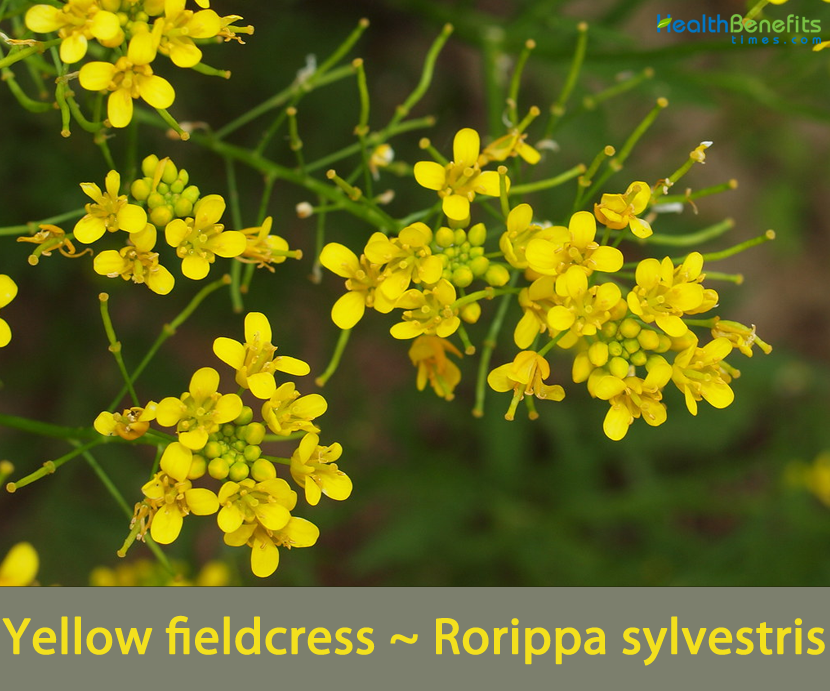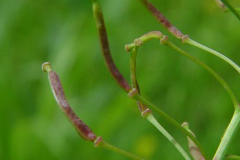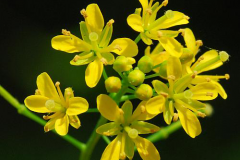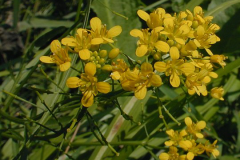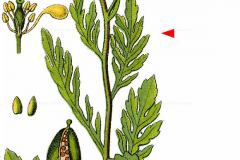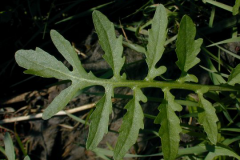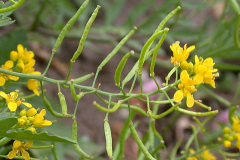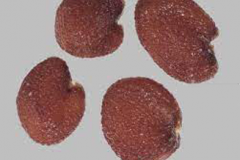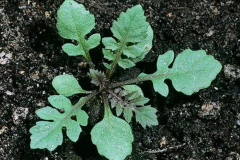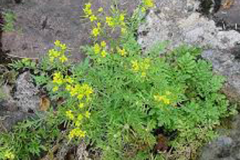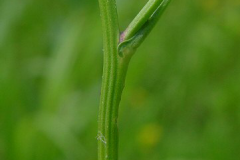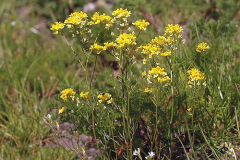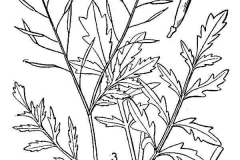| Yellow fieldcress Quick Facts | |
|---|---|
| Name: | Yellow fieldcress |
| Scientific Name: | Rorippa sylvestris |
| Origin | Native to Europe and Asia and now widely established throughout North America |
| Colors | Initially green turning to brown as they mature |
| Shapes | Many seeded, linear, slender silique up to ½ inch (10 to 15 mm) long on a slender pedicel about 1/3 inches (8 mm.) long |
| Taste | Peppery taste |
| Name | Yellow fieldcress |
|---|---|
| Scientific Name | Rorippa sylvestris |
| Native | Native to Europe and Asia and now widely established throughout North America |
| Common Names | Creeping yellow cress, Creeping yellow field cress, Yellow field cress, keek |
| Name in Other Languages | Afrikaans: Keek Albanian: Roripa e pyllit, roripë, Keek Amharic: Kēki (ኬክ) Arabic: Kayk (كيك) Armenian: Kek (կէկ) Azerbaijani: Qəşəng Belarusian: Žarušnik liasny (Жарушнік лясны) Bengali: Curi karē dēkhā (চুরি করে দেখা) Bulgarian: Gorski porech (горски пореч), nadzŭrtam (надзъртам) Burmese: Kyinnar (ကြင်နာ) Catalan: Creixen silvestre Chinese: Ou ya han cai, Ōu yà tíng lì (歐亞葶藶), Jí kè (極客), Goku kyaku Croatian: Sumski grbak, špijunirati Czech: Rukev obecná, rukev lesní, pokukovat Danish: Vej-guldkarse, Keek, Rund løg, Rævehale-amarant, Top-amarant, Vej-guldkarse Dutch: Akkerkers, keek English: Creeping yellow cress, Creeping yellow field cress, Yellow field cress, keek Esperanto: Fervora Estonian: Metskerss, keek Filipino: Keek Finnish: Rantanenätti, Rikkanenätti, кikkanenätti, keek French: Cresson des bois, Cresson sauvage, Rorippe sylvestre, Rorippe des forêts, rorippe des champs, caquette sauvage, cresson des forêts, cresson sauvage, cresson sauvage, herbe à l’empereur, roquette sauvage, rorippe des forêts, keek Georgian: Keik’I (ქეიკი) German: Wald-Sumpfkresse, Wilde-Sumpfkresse, Waldkresse, wilde Kresse, keek Greek: Róripa dasikí (ρόριπα δασική), entáxei (εντάξει) Gujarati: Kīka (કીક) Hausa: Keek Hebrew: בקי Hungarian: Erdei kányafű, ishkap kányafű, kukucskál Icelandic: Flækjujurt, keek Indonesian: Mengintai Irish: Biolar buí reatha, keek Italian: Crescione radicina, crescione di fiume, nasturzio Japanese: Kireha inu garashi (キレハイヌガラシ), kirenoinuka rashi (キレノイヌカ ラシ), yachiinugarashi, Kīku (キーク) Javanese: Keek Kannada: Kīk (ಕೀಕ್) Kazakh: Kek (кек) Korean: Deul-yeoda boda (들여다 보다) Kurdish: Keek Lao: Keek Latin: Keek Latvian: Meža paķērsa, keksis Lithuanian: Miškinis čeriukas, keek Macedonian: Keek (кеек) Malagasy: Keek Malay: Keek Malayalam: Kīkk (കീക്ക്) Maltese: Akkan Marathi: Keek (कीक) Mongolian: Khachin (хачин) Nepali: Keek Netherlands: Akkerkers Norwegian: Vegkarse, keek, Skou-sennep, Veikarse Northern Sami: Gáddekrássa Occitan: Escarrabilhe, nasitort salvatge Oriya: Keek Pashto کیک Persian: ترتیزک زرد جنگلی Polish: Rzepicha leśna, Keek Portuguese: Agrião Silvestre, agrião-amarelo, agrião-rastejante, keek Punjabi: Keek Romanian: Keek Russian: Zherushnik lesnoy (Жерушник лесной), -podglyadyvat (подглядывать) Serbian: Zutenica (жутеница), žuti ugaz (жути угаз), obični grbak (обични грбак), keek (кеек) Sinhala: Keek Slovak: Roripa lesná Slovene: Divja potočarka, gozdna potočarka, keek Spanish: Oruga palustre, roqueta palustre, romper a Sundanese: Keek Swedish: Strandfräne, keek, Grönamarant, Kirgislök, Rundlök, Rävsvans, Segerlök, Rikkanenätti, Trädgårdsgräslök, Strandkrasse, Strandsenap Tajik: Gurext (гурехт) Tamil: Kīk (கீக்) Telugu: Keek Thai: Mxng lxd (มองลอด) Turkish: Cakandura, gizlice bırakıvermek Ukrainian: Vodyanyy khrin lisovyy (Водяний хрін лісовий), kik (кик) Urdu: کیک Uzbek: Qip-qizil Vietnamese: Keek Welsh: Berwr melyn ymlusgol, berwr melyn ymlysgil y dwr, keek, Berwr Melyn Blynyddol y Dŵr, Berwr Melyn Ymlusgol, Berwr Melyn Ymlusgol y Dŵr, Berwy Melyn Ymlusgol y Dwfr, Berwyr Melyn Blynyddol y Dŵr Zulu: Keek |
| Plant Growth Habit | Perennial herbaceous plant |
| Growing Climates | Disturbed wetlands, muddy or grassy borders of ditches, soggy meadows, floodplain areas, poorly drained areas along railroads, waste places, nurseries, along streams, near cultivated fields, wet lands, along ditches, damp areas, plains, valleys, sandy beaches, gardens, flower beds, park lawns and roadside embankments |
| Soil | Preference is full sunlight, wet to moist conditions, and a mucky soil with abundant organic matter. Temporary flooding is tolerated, although more or less permanent standing water is not. This plant withstands occasional mowing |
| Plant Size | 20–50 cm (8–20 in.) tall |
| Root | Root system produces abundant rhizomes and vegetative offsets of the mother plant; sometimes a prostrate lower stem will form rootlets near the leaf axils on moist ground. This plant often forms colonies |
| Stem | Creeping, ascending branches, glossy or with a few sparse hairs |
| Leaf | Basal and lower stem leaves are glabrous, pinnately lobed, and oblong-ovate or lanceolate-ovate in outline. The terminal lobe is often broader than the other lobes. They are up to 8 inches (to 20 cm) long and ¾ inch wide, deeply divided into lobes that may be further lobed or have coarsely toothed edges |
| Flowering season | October to March |
| Flower | Each flower is about 1/3 inches (8 mm.) across when fully open, consisting of 4 yellow petals 3 to 5 mm long, rounded, spatula shaped, and 4 yellow green sepals. Stamens are 6, erect, 4 larger and 2 smaller. Filaments are yellow, glabrous, to 3mm long. |
| Fruit Shape & Size | Many seeded, linear, slender silique up to ½ inch (10 to 15 mm) long on a slender pedicel about 1/3 inches (8 mm.) long |
| Fruit Color | Initially green turning to brown as they mature |
| Seed | Seeds (rarely produced), usually uniseriate, rarely sub-biseriate, reddish brown, ovoid, 0.5-0.9 mm (0.4-0.5 mm diam.), colliculate |
| Taste | Peppery taste |
| Propagation | By seed and vegetatively by rhizomes |
| Season | November to March |
| Culinary Uses |
|
Plant Description
Yellow fieldcress is a perennial herbaceous plant that normally grows about 20–50 cm (8–20 in.) tall. The plant is found growing in disturbed wetlands, muddy or grassy borders of ditches, soggy meadows, floodplain areas, poorly drained areas along railroads, waste places, nurseries, along streams, near cultivated fields, wet lands, along ditches, damp areas, plains, valleys, sandy beaches, gardens, flower beds, park lawns and roadside embankments. The plant prefers full sunlight, wet to moist conditions, and a mucky soil with abundant organic matter. Temporary flooding is tolerated, although more or less permanent standing water is not. This plant can also withstand occasional mowing. Root system produces abundant rhizomes and vegetative offsets of the mother plant; sometimes a prostrate lower stem will form rootlets near the leaf axils on moist ground. This plant often forms colonies.
Stem
Stems are erect to ascending to prostrate, usually branched, ribbed, hairless or with sparse hairs on the lower stem. The lower stem of this plant has a tendency to sprawl along the ground in the absence of supportive vegetative; otherwise it is more or less erect. Both the lower and upper stems are glabrous, angular, and somewhat succulent. Plants can form dense colonies from creeping, underground stems (rhizomes).
Leaves
Young plants form basal rosettes that disappear after the first year. Basal and lower stem leaves are glabrous, pinnately lobed, and oblong-ovate or lanceolate-ovate in outline. The terminal lobe is often broader than the other lobes. They are up to 8 inches (to 20 cm) long and ¾ inch wide, deeply divided into lobes that may be further lobed or have coarsely toothed edges. Leaves are hairless and become smaller and the divisions narrower as they ascend the stem. The margins of the leaves are bluntly dentate, shallowly lobed, or undulate.
Flower
The upper stems terminate in racemes of yellow flowers. These flowers bloom near the apex of the raceme, while the siliques on spreading pedicels develop below. Each flower is about 1/3 inches (8 mm.) across when fully open, consisting of 4 yellow petals 3 to 5 mm long, rounded, spatula shaped, and 4 yellow green sepals. Stamens are 6, erect, 4 larger and 2 smaller. Filaments are yellow, glabrous, to 3mm long. Anthers yellow, 1mm long. Ovary is cylindrical, green-yellow, glabrous, 2mm long in flower, superior. The blooming period occurs from early to mid-summer and lasts about 1½ months.
Fruit
Each fertile flowers are replaced by many seeded, linear, slender silique up to ½ inch (10 to 15 mm) long on a slender pedicel about 1/3 inches (8 mm.) long. Each silique is straight or slightly curved, terminating in a short beak. Fruits are initially green turning to brown as they mature. Fruit consists of several tiny seeds that can probably float on water or blow about in the wind.
Other Facts
- Seed is produced 2 to 3 times per year
- Plants spread by growing additional shoots from the crown or from the roots.
- Creeping field cress has the potential to become a serious weed in greenhouse, container and field ornamentals.
- It has been confirmed in container and greenhouse crops in California in 1998.
- Seed-eating pet birds such as canaries also relish the seeds.
- Other historic uses include various medicinal applications, with varying degrees of effectiveness.
References:
https://www.itis.gov/servlet/SingleRpt/SingleRpt?search_topic=TSN&search_value=23017#null
https://gd.eppo.int/taxon/RORSY
http://www.misin.msu.edu/facts/detail/?project=&id=433&cname=Creeping%20yellowcress
http://www.theplantlist.org/tpl1.1/record/kew-2417195
https://gobotany.nativeplanttrust.org/species/rorippa/sylvestris/
https://www.flowersofindia.net/catalog/slides/Yellow%20Fieldcress.html
https://indiabiodiversity.org/species/show/245824
http://www.efloras.org/florataxon.aspx?flora_id=2&taxon_id=200009673
https://www.nzpcn.org.nz/flora/species/rorippa-sylvestris/
https://en.wikipedia.org/wiki/Rorippa_sylvestris
http://www.efloras.org/florataxon.aspx?flora_id=1&taxon_id=200009673
https://www.minnesotawildflowers.info/flower/creeping-yellow-cress
https://www.illinoiswildflowers.info/weeds/plants/creeping_cress.htm
https://www.cabi.org/isc/datasheet/47792
https://plants.usda.gov/home/plantProfile?symbol=ROSY


